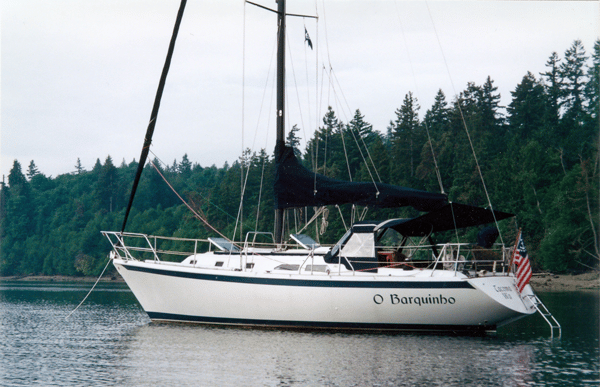
Between 1969 and 1982, Ericson Yachts built about 600 Ericson 35 Mark IIs, a then-modern racer/cruiser designed by Bruce King to replace the original Ericson 35. Many still sail in both saltwater and freshwater locales across the continent.
With her comparatively light displacement, our 1977 Ericson 35 Mark II, Mino’aka, hull number 480, fairly danced through the water. Her helm was neutral until wind speeds reached about 18 knots. Above that, she’d show some weather helm, which could be eliminated by easing the traveler or reducing sail. Once in her easy and forgiving “groove,” she tracked with hardly a hand on the wheel, even in seas of 4 or 5 feet. Average sailing speeds in light Southern California conditions ranged from 4 to 6 knots.
Head-turning classic lines and an original light-blue hull elicited many compliments for Mino’aka. Although she came with such factory upgrades as a teak-and-holly cabin sole, satin-varnished mahogany trim, and that unique gelcoat color, the systems were basic and maintenance demands minimal. We replaced the original (and frightening) wiring and added two new 6-volt AGM house batteries and a separate starting battery, which provided the simple electrics with ample power for a week or more of cruising off the grid. We supplemented the 25-gallon water tankage with sun showers for bathing and bottled water for drinking.
The galley on the 35 Mark II, located to starboard of the companionway, is better than adequate, with plenty of storage and a cavernous icebox that, after we added closed-cell insulation to its outside, kept block ice frozen for at least five days.
A roomy quarter berth to port is the most comfortable bunk on the boat. Forward of it is a full-size chart table and an electronics shelf. Amidships to port, a U-shaped seating area surrounds the removable dining table, which also converts to a double berth; the straight settee opposite can serve as another single. Storage is provided above, behind, and under the seating.
Forward, a hanging locker and shelves face the enclosed head to port. For hot-water bathing on Mino’aka, we’d suspend a sun shower from a halyard above the ventilation hatch. The fine bow makes the V-berth narrow at the peak.
After a particularly nasty crossing to Santa Cruz, one of California’s Channel Islands, Mino’aka developed a peculiar creaking sound at anchor. We later traced it to a pulled bulkhead tab. Like other owners, we found and repaired soft areas in the deck’s balsa core, particularly around the chainplates. To cure persistent leaks, we pulled all of the windows, fitted new gaskets, then rebedded them. The welded seams on the aluminum fuel tank were beginning to fail, so we replaced it with a custom stainless-steel tank.
Mino’aka still had the original, well-maintained, 30-horsepower Atomic 4 gasoline engine. A true workhorse, it provided 6 to 6.5 knots in calm conditions but was a bit underpowered for motoring into wind and waves.
Some hulls have suffered from blisters. Mino’aka had many small ones that would’ve been fairly easy to treat, but they remained unchanged from the time we bought her and caused no problems.
The graceful Ericson 35 Mark II continues to be popular because it’s fun to sail and packs lots of space into an inexpensive yet solid coastal cruiser. Asking prices range from $19,000 to $35,000. Ericson owners love their boats and share information through active owner groups and e-mail discussion lists.
Ericson 35 Mark II
LOA 34′ 8″ (10.57 m.)
LWL 25′ 10″ (7.87 m.)
Beam 10′ 0″ (3.05 m.)
Draft 4′ 11″ (1.50 m.)
Sail Area (100%) 533 sq. ft. (49.51 sq. m.)
Ballast 5,000 lb. (2,268 kg.)
Displacement 11,600 lb. (5,261 kg.)
Ballast/D .43
D/L 300
SA/D 16.6
Water 25 gal. (95 l.)
Fuel 22 gal. (83 l.)
Engine 30-hp. Atomic 4; gasoline
Designer Bruce King
The Falks sold Mino’aka and now sail a J/40, Kaholo, out of Redondo Beach, California.








